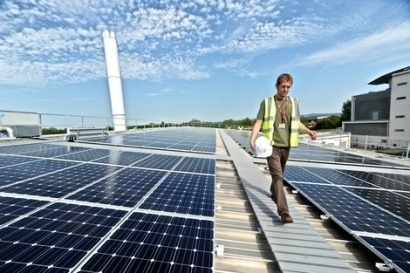
The system has been in place for a year now but despite some terrible weather over the past 12 months the Met Office’s PV array on the roof of its Exeter HQ has still out-performed initial expectations.
Official figures show that 2012 was one of the wettest years on record for the UK with June 2012 being the least sunny month since 1910. Nevertheless, the system, design and installed by Exeter firm SunGift Energy, managed to generate 221,854kWh of renewable electricity, 747 kWh more than estimated and sufficient to power more than 67 houses.
“Since the array was installed in June last year we’ve seen six months of below average sunshine and one of the wettest summers on record” said Peter Clayton-White, Building Services Engineer at the Met Office, “but the system has still provided more power than we expected – which is very encouraging looking to the future of this investment.”
The solar array was completed in June 2012 and generates around 1,000 kilowatt hours of electricity per day, enough energy to power one of the Met Office’s supercomputers. Solar PV arrays can generally pay for themselves in as little as five years with a further 15 years worth of income from Feed-in Tariff payments and around 30 to 40 years of free electricity. In the year since they installed the Met Office system SunGift has installed PV systems for householders and businesses and other non-domestic customers such as Numatic International in Chard, a company that manufactures Henry vacuum cleaners. Exeter City Council and Teignbridge District Council have also had SunGift systems installed on their roofs. Demand continues to be strong through 2013 with the company installing over 2MW of systems so far.
“This is great news for anyone thinking of to opting for solar PV,” said Gareth Walton of SunGift Energy, “because if systems are exceeding estimates even in poor weather conditions – just think how well they’re currently performing while the country is basking in sunshine. The Met Office’s solar system demonstrates how beneficial solar PV is for both non-domestic and domestic customers. It has reduced their electricity bills, helping protect them from rising energy costs, generated a substantial income from the Feed-in Tariff, and cut their carbon emissions, boosting their green credentials.”
SunGift uses specialist solar PV industry design software in order to estimate how much electricity will be generated by the systems they install. The benefits of using such a system is that it tends not to over-estimate output in the way that some other methods do.
“While high estimates initially sound attractive, they can leave customers unhappy when their systems don’t perform as expected” Walton added. “SunGift deliberately choses a method that gives a realistic, but slightly conservative, estimate because we prefer to install systems that outperform estimates and leave our customers happy.”
Further information:

